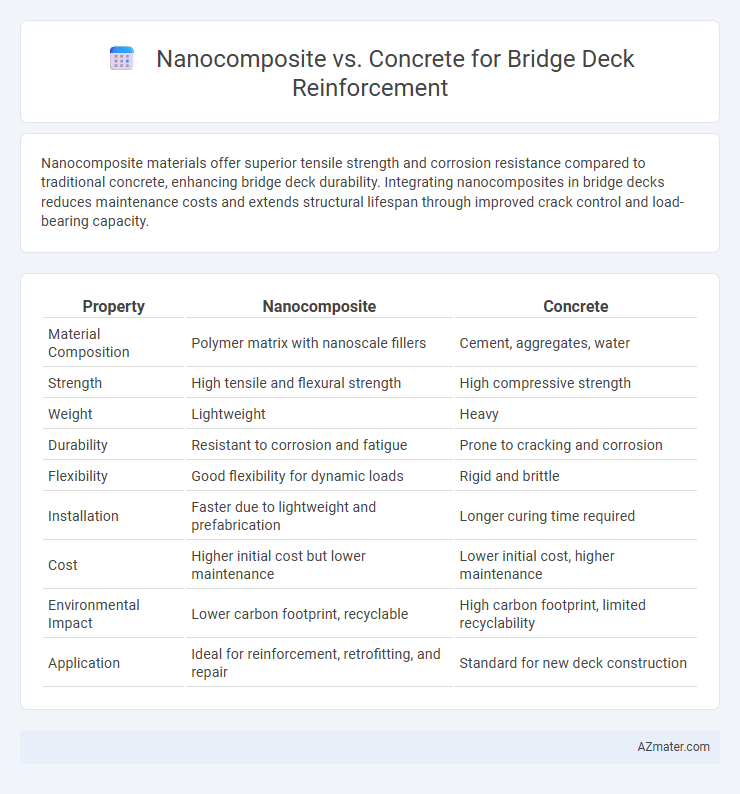Nanocomposite materials offer superior tensile strength and corrosion resistance compared to traditional concrete, enhancing bridge deck durability. Integrating nanocomposites in bridge decks reduces maintenance costs and extends structural lifespan through improved crack control and load-bearing capacity.
Table of Comparison
| Property | Nanocomposite | Concrete |
|---|---|---|
| Material Composition | Polymer matrix with nanoscale fillers | Cement, aggregates, water |
| Strength | High tensile and flexural strength | High compressive strength |
| Weight | Lightweight | Heavy |
| Durability | Resistant to corrosion and fatigue | Prone to cracking and corrosion |
| Flexibility | Good flexibility for dynamic loads | Rigid and brittle |
| Installation | Faster due to lightweight and prefabrication | Longer curing time required |
| Cost | Higher initial cost but lower maintenance | Lower initial cost, higher maintenance |
| Environmental Impact | Lower carbon footprint, recyclable | High carbon footprint, limited recyclability |
| Application | Ideal for reinforcement, retrofitting, and repair | Standard for new deck construction |
Introduction to Bridge Deck Reinforcement Materials
Nanocomposite materials offer enhanced mechanical properties and durability compared to traditional concrete for bridge deck reinforcement. These advanced composites incorporate nanoparticles, such as carbon nanotubes or graphene, which improve tensile strength, crack resistance, and corrosion protection. Concrete, while widely used for its cost-effectiveness and compressive strength, often requires additional reinforcement like steel rebar to address its brittleness and vulnerability to environmental degradation.
Overview of Conventional Concrete
Conventional concrete, widely used for bridge deck reinforcement, consists of cement, water, aggregates, and admixtures, providing compressive strength but limited tensile capacity. Its brittleness and susceptibility to cracking pose durability challenges under cyclic loads and environmental exposure. Enhancements often require steel reinforcement, yet conventional concrete's lack of flexibility leads to corrosion risks and maintenance issues over time.
Understanding Nanocomposites in Construction
Nanocomposites in bridge deck reinforcement enhance mechanical strength and durability by integrating nanoscale fillers like carbon nanotubes or graphene into concrete matrices, leading to improved crack resistance and reduced permeability. Unlike traditional concrete, nanocomposites offer superior load-bearing capacity and resistance to environmental degradation, extending the lifespan of bridge decks under heavy traffic and harsh weather conditions. Research indicates that nanocomposite-reinforced concrete exhibits increased tensile strength and better corrosion resistance, making it a transformative material in modern civil engineering applications.
Mechanical Properties: Nanocomposite vs Concrete
Nanocomposites exhibit significantly higher tensile strength and improved fracture toughness compared to conventional concrete, enhancing the durability of bridge deck reinforcement under dynamic loads. The nanoscale fillers in nanocomposites improve stiffness and reduce crack propagation, leading to superior mechanical performance in bridge applications. These enhancements translate to longer service life and reduced maintenance costs for reinforced bridge decks.
Durability and Longevity Comparison
Nanocomposite materials exhibit superior durability and longevity compared to traditional concrete in bridge deck reinforcement due to their enhanced resistance to cracking, corrosion, and environmental degradation. The incorporation of nanoparticles such as carbon nanotubes or nano-silica improves the matrix density and interfacial bond strength, significantly extending service life under cyclic loading and harsh weather conditions. Studies demonstrate nanocomposite-reinforced bridge decks maintain structural integrity beyond 50 years, outperforming conventional concrete which often requires major repairs within 20 to 30 years.
Resistance to Environmental Factors
Nanocomposite materials exhibit superior resistance to environmental factors compared to traditional concrete in bridge deck reinforcement, offering enhanced durability against moisture intrusion, freeze-thaw cycles, and chemical corrosion. The incorporation of nanoparticles in nanocomposites improves barrier properties and reduces permeability, significantly mitigating damage from chloride ions and deicing salts. This results in prolonged service life and reduced maintenance costs for bridge structures exposed to harsh environmental conditions.
Cost Analysis and Economic Feasibility
Nanocomposite materials for bridge deck reinforcement offer higher initial costs compared to traditional concrete due to advanced manufacturing processes and raw material expenses. However, their superior durability, resistance to corrosion, and reduced maintenance requirements lead to significant long-term economic benefits and cost savings. Life-cycle cost analysis reveals that despite higher upfront investment, nanocomposites provide enhanced economic feasibility through extended service life and lower repair frequency.
Installation and Maintenance Considerations
Nanocomposite materials for bridge deck reinforcement offer simplified installation due to their lightweight nature and superior bonding properties, reducing labor time and equipment costs compared to traditional concrete. Maintenance is minimized as nanocomposites exhibit enhanced durability, corrosion resistance, and crack mitigation, leading to extended service life and fewer repair interventions. Concrete reinforcement requires more frequent inspections and maintenance to address cracking, spalling, and corrosion of steel reinforcement, increasing long-term operational expenses.
Case Studies: Real-World Applications
Case studies reveal nanocomposite materials significantly enhance bridge deck reinforcement by improving durability and reducing weight compared to traditional concrete. Projects incorporating carbon nanotube-infused composites show up to 40% increase in tensile strength and extended lifespan under heavy traffic loads. These real-world applications demonstrate nanocomposites' superior resistance to corrosion and cracking, leading to lower maintenance costs and longer service intervals.
Future Trends in Bridge Deck Reinforcement Materials
Nanocomposite materials offer enhanced mechanical properties, corrosion resistance, and weight reduction compared to traditional concrete in bridge deck reinforcement, promising longer service life and reduced maintenance costs. Future trends emphasize integrating smart nanomaterials capable of self-sensing and self-healing, improving durability and real-time structural health monitoring. Advances in nanotechnology combined with sustainable engineering practices will drive the adoption of multifunctional nanocomposite-reinforced bridge decks in infrastructure development.

Infographic: Nanocomposite vs Concrete for Bridge deck reinforcement
 azmater.com
azmater.com